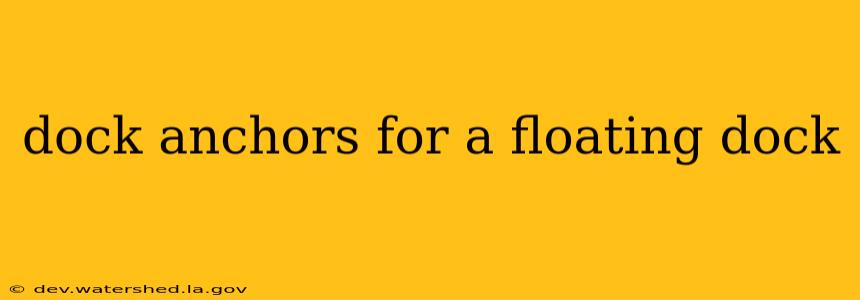Choosing the right dock anchors is crucial for the safety and longevity of your floating dock. A poorly anchored dock can shift, become damaged, or even become a hazard during storms or high winds. This comprehensive guide will help you understand the various types of dock anchors available and how to choose the best ones for your specific needs.
What are the Different Types of Dock Anchors?
Several types of anchors are suitable for securing floating docks, each with its own advantages and disadvantages. The best choice depends on factors like water depth, bottom composition (mud, sand, rock, etc.), and the size and weight of your dock.
-
Screw Anchors: These anchors are driven into the lakebed using a specialized tool. They're excellent for soft bottoms like mud or sand and offer good holding power. Their installation requires specialized equipment and may not be suitable for rocky or hard-packed bottoms.
-
Deadman Anchors: These anchors consist of a heavy object (like a concrete block or a large piece of timber) buried in the lakebed, connected to the dock via a strong cable or chain. They provide excellent holding power and are suitable for various bottom types, but their installation is labor-intensive.
-
Stake Anchors: These are long, sturdy stakes driven into the lakebed. Like screw anchors, they’re effective in softer substrates, but their holding power can be less than that of deadman anchors, especially in strong currents or high winds.
-
Sand Anchors: Specifically designed for sandy bottoms, these anchors utilize the principle of expanding to create a large surface area for holding power. They’re relatively easy to install and remove, but their effectiveness is entirely dependent on the consistency of the sand.
-
Rock Anchors: Designed for rocky or hard bottoms, these anchors use specialized designs to grip into crevices and cracks. They are the most challenging to install and require specific tools, but they offer superior holding power in the appropriate setting.
How Do I Choose the Right Anchor for My Floating Dock?
Choosing the correct anchor system involves carefully considering several factors:
-
Water Depth: Deeper water typically requires longer anchors or more sophisticated anchoring systems.
-
Bottom Composition: The type of bottom (mud, sand, rock, etc.) directly influences the best anchor type. Screw and stake anchors are best for soft bottoms, while deadman anchors are more versatile, and rock anchors are ideal for rocky substrates.
-
Dock Size and Weight: A larger, heavier dock requires more robust anchors to ensure adequate holding power.
-
Environmental Conditions: Consider the typical weather conditions in your area. Areas prone to strong winds or currents will necessitate stronger, more securely anchored docks.
What is the Best Material for Dock Anchors?
The anchor material should be chosen based on its durability and resistance to corrosion. Common materials include:
-
Galvanized Steel: Offers a good balance of strength and corrosion resistance, though it will eventually degrade over time.
-
Stainless Steel: More expensive but provides superior corrosion resistance and a longer lifespan.
How Many Anchors Do I Need for My Floating Dock?
The number of anchors depends on the size and weight of your dock, water conditions, and the holding power of each anchor. It’s always better to over-anchor than under-anchor. Consulting with a professional dock builder is recommended to determine the optimal number of anchors for your specific situation.
How Deep Should My Dock Anchors Be?
Anchor depth requirements vary widely depending on the type of anchor used, soil conditions, and water depth. It is crucial to choose anchor systems that are appropriately rated for your conditions. Insufficient depth leads to poor holding power and potential damage to your dock.
What Maintenance Do Dock Anchors Require?
Regular maintenance is essential to ensure your anchors remain effective and your dock stays secure. This includes periodic inspections for corrosion, damage, and shifting. Loose anchors should be tightened or replaced as needed.
By carefully considering these factors, you can choose the right dock anchors to ensure your floating dock is safe, secure, and enjoyable for years to come. Remember to always consult with a professional for advice tailored to your specific needs and local conditions.
